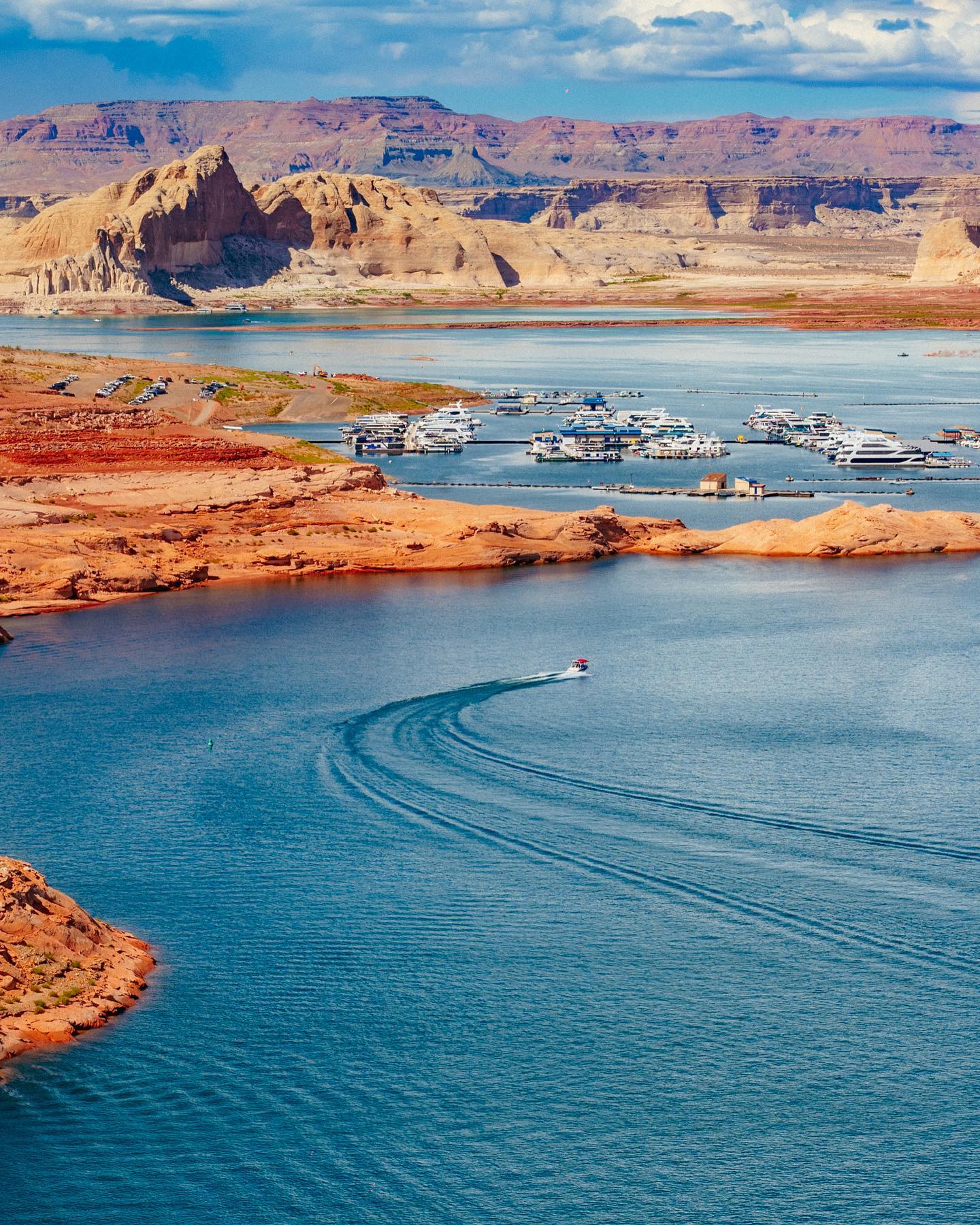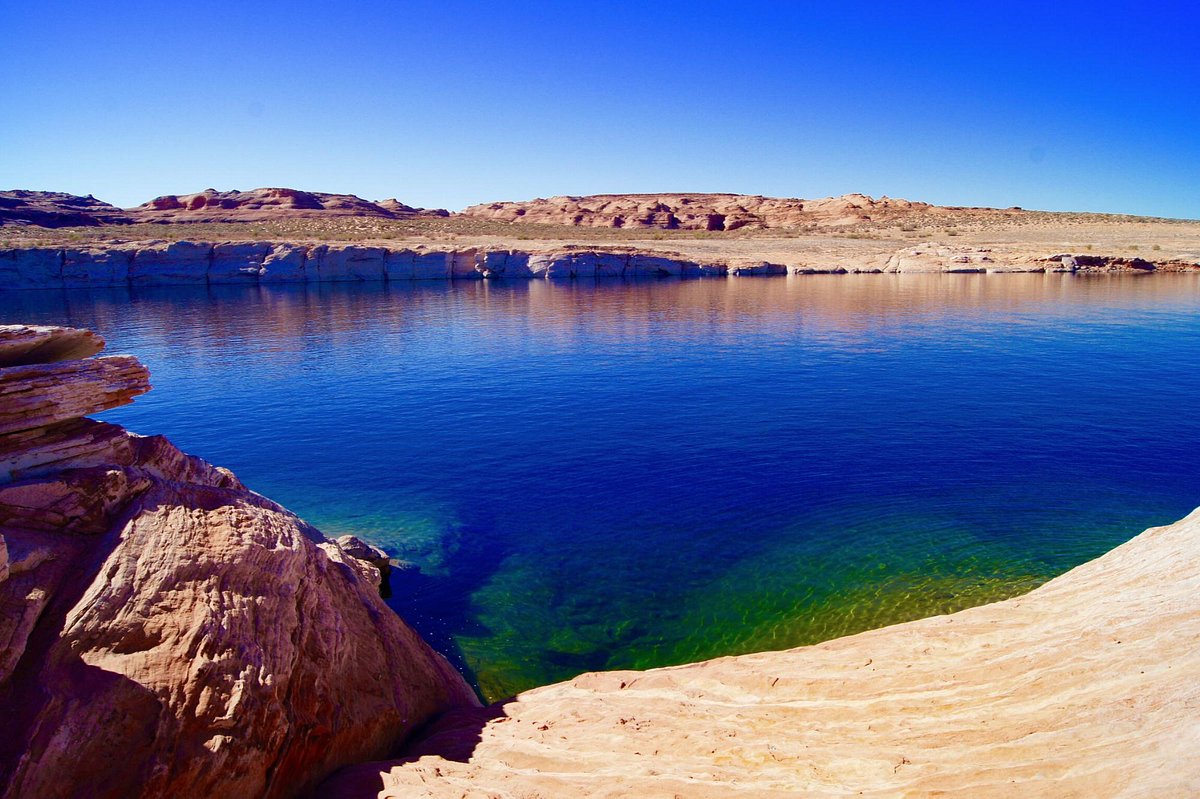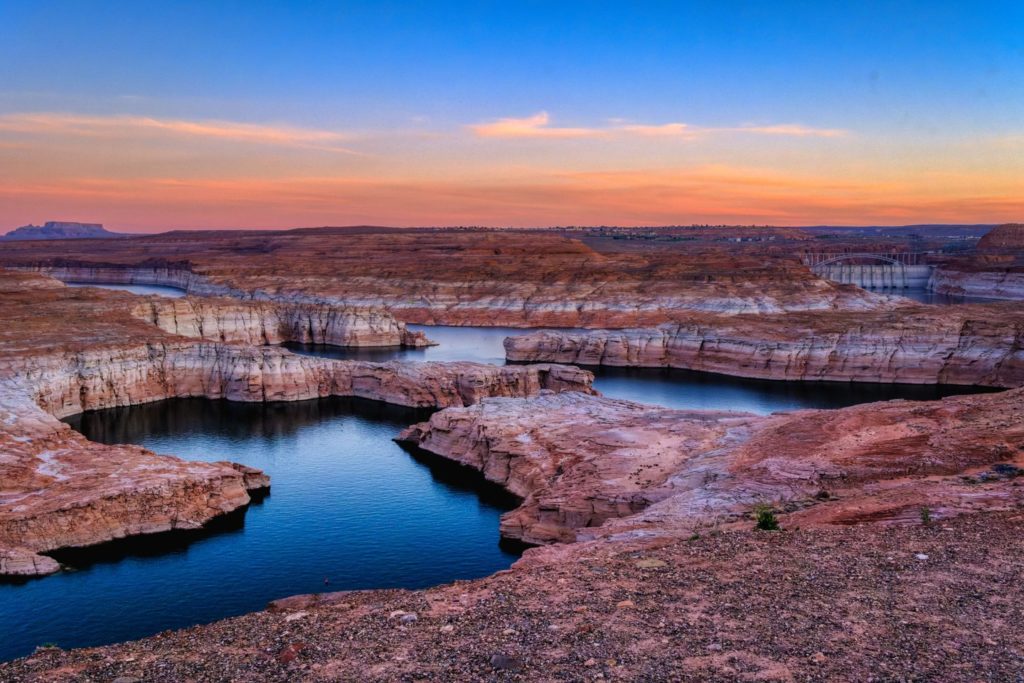Lake Powell Page offers breathtaking views of crystal-clear waters and dramatic landscapes.
BOok A FLIGHT





Lake Powell, located in northern Arizona and extending into southern Utah, is a reservoir on the Colorado River and a key feature of the Glen Canyon National Recreation Area. It is named after explorer John Wesley Powell, who led a scientific expedition down the Colorado River in 1869. The creation of Lake Powell was a result of the construction of the Glen Canyon Dam, which was completed in 1963. Here are some of its key features:
Size and Capacity: Lake Powell is the second-largest man-made reservoir in the United States by maximum water capacity, after Lake Mead. It stretches over 186 miles in length and has a shoreline that spans approximately 1,960 miles when the lake is at full capacity.
Recreational Activities: The lake is a popular destination for boating, fishing, swimming, and water sports. Its clear blue waters and surrounding desert landscape offer a unique setting for outdoor recreation. Houseboating is particularly popular, allowing visitors to explore the lake's numerous side canyons and hidden coves.
Scenic Beauty: The lake is renowned for its stunning natural beauty, with towering red rock formations, sandy beaches, and clear waters. Iconic locations such as Rainbow Bridge National Monument, one of the world's largest natural bridges, and Horseshoe Bend, a dramatic curve in the Colorado River, are accessible from Lake Powell.
Environmental and Cultural Significance: The creation of Lake Powell submerged a significant portion of Glen Canyon, which was known for its archaeological sites and natural beauty. This has led to ongoing debates about the environmental impact of the reservoir. The area is also culturally significant to several Native American tribes.
Tourism and Economy: Lake Powell is a major tourist destination, attracting millions of visitors each year. The city of Page, Arizona, serves as a gateway to the lake, providing accommodations, dining, and other services for tourists. The lake's tourism industry is a vital part of the local economy.
Water Resource: Beyond recreation, Lake Powell plays a crucial role in water storage, hydroelectric power generation, and river flow regulation for the Upper Colorado River Basin. It helps ensure water availability for agriculture, municipalities, and industry in the arid Southwest.
Climate Change and Water Levels: The lake's water levels have fluctuated significantly in recent years due to prolonged droughts and changing climate patterns, raising concerns about water security in the region. These fluctuations can affect recreational access and the ecological health of the area.
Lake Powell's combination of natural beauty, recreational opportunities, and its role in water management make it a significant feature of the American Southwest.
Feels like 46°F. clear sky
clear sky
clear sky
clear sky
broken clouds
scattered clouds
clear sky
clear sky
Lake Powell, located on the border between Utah and Arizona, is a major vacation spot known for its stunning scenery, water sports, and outdoor activities. Page, Arizona, is a common gateway for visitors to Lake Powell. Here's how you can get to Lake Powell, specifically focusing on reaching it via Page:
Fly into Page Municipal Airport (PGA): This is the closest airport to Lake Powell, located in Page, Arizona. It handles mainly regional or private flights. If you're coming from farther away, you might need to connect through a larger airport.
Fly into a Major Nearby Airport: The closest major airports are McCarran International Airport (LAS) in Las Vegas, Nevada, and Phoenix Sky Harbor International Airport (PHX) in Phoenix, Arizona. From there, you can rent a car and drive to Page.
Driving is the most common way to reach Lake Powell and offers a scenic route through the American Southwest. Here are the approximate driving times from nearby cities:
There are bus services and shuttle companies that operate routes from major cities or airports to Page, Arizona. However, these services may not be as frequent as those to larger destinations, so it's essential to plan ahead and check the current schedules.
Regardless of how you choose to get there, visiting Lake Powell and the surrounding region offers a memorable experience with its breathtaking landscapes and outdoor activities.
Lake Powell is located on the border between Utah and Arizona in the United States. The city of Page, which is often associated with Lake Powell due to its proximity and access to the lake, is situated in northern Arizona. Page serves as a popular base for tourists and visitors looking to explore Lake Powell, the Glen Canyon National Recreation Area, and other nearby attractions such as Antelope Canyon and Horseshoe Bend. Lake Powell itself is a man-made reservoir on the Colorado River, created by the flooding of Glen Canyon with the completion of the Glen Canyon Dam in 1963. It is the second-largest artificial lake in the United States and is known for its stunning landscape of clear blue water contrasted against red rock canyons and formations.
The best time to visit Lake Powell, located near Page, Arizona, is typically during the spring (April to June) or fall (September to October) months. These periods offer more moderate temperatures, making outdoor activities such as boating, hiking, and sightseeing around the lake and nearby attractions like Antelope Canyon more enjoyable.
Summer months (July and August) can be extremely hot, with temperatures often exceeding 100°F (38°C), which might be less comfortable for outdoor activities. However, summer is still a popular time for visitors looking to engage in water activities to cool off.
Visiting in the spring offers the added benefit of seeing the desert in bloom and generally lower water levels, which can reveal more of the canyon's structure. Fall provides pleasant temperatures and fewer crowds, with the changing season bringing beautiful colors to the landscape.
Ultimately, the best month to visit depends on your personal preferences for weather, crowd levels, and what you want to do during your visit.
The time needed to explore Lake Powell and the surrounding Page area depends on your interests and the activities you plan to do. Lake Powell, located on the border of Utah and Arizona, offers a wide range of activities including boating, fishing, swimming, hiking, and exploring nearby attractions such as Antelope Canyon and Horseshoe Bend. Here's a rough guide to help you plan:
Ultimately, the duration of your visit to Lake Powell and Page depends on how deeply you wish to explore the area and engage in the available activities.
Lake Powell, located in Page, Arizona, is one of the most fascinating man-made reservoirs in the United States, offering a wealth of interesting facts and features:
Creation and Purpose: Lake Powell was created by the flooding of Glen Canyon by the Glen Canyon Dam, which was completed in 1966. The dam was built as part of the Colorado River Storage Project, primarily for water storage, hydroelectric power generation, and flood control.
Size and Scope: It is the second-largest man-made reservoir in the United States by maximum water capacity, after Lake Mead. The lake extends up to 186 miles upstream from the dam, with a surface area of approximately 161,390 acres when full.
Geography and Landscape: The lake is situated on the Colorado River, straddling the border between Arizona and Utah. It is known for its stunning landscape, featuring nearly 2,000 miles of shoreline, more than the entire west coast of the continental United States, and countless canyons, creating a breathtaking backdrop for water-based and outdoor activities.
Recreational Paradise: Lake Powell is a major vacation spot, attracting approximately two million visitors annually. It is popular for boating, fishing, swimming, and water sports. Houseboating is particularly popular, offering a unique way to explore the lake and its canyons.
Archaeological and Cultural Significance: The region around Lake Powell and Glen Canyon is rich in archaeological sites, including ancient Puebloan ruins and rock art, which provide insights into the early inhabitants of the area.
Environmental Concerns and Changes: The creation of Lake Powell submerged significant portions of Glen Canyon, sparking environmental debates about the impact of large dams on natural landscapes. Additionally, water levels in Lake Powell fluctuate due to variable rainfall and water demand, affecting both recreational opportunities and water resource management. In recent years, prolonged drought in the southwestern United States has led to historically low water levels in Lake Powell, highlighting concerns about water security and climate change.
Rainbow Bridge National Monument: One of the lake's most famous attractions is Rainbow Bridge, one of the world's largest known natural bridges. The monument is considered sacred by several Native American tribes and is accessible by boat or hiking trails.
Film and Media: Lake Powell has been a popular location for filming movies and television shows due to its unique and dramatic landscape. It has been featured in films such as "Planet of the Apes" (1968) and "Gravity" (2013), among others.
Lake Powell's combination of natural beauty, recreational opportunities, and environmental significance makes it a unique and compelling destination, as well as a subject of ongoing study and debate regarding water management in the arid West.